Have you ever wondered why some people seem to reach exceptional levels of success, even if they seem average in other ways?
Not everyone is born with an innate talent for something, but that doesn’t mean they can’t cultivate skills that can take them to their highest level of achievement.
But how do you do that? Getting ahead and striving to be exceptional might just be a matter of some good habits and strategic planning.
Start at the End
When you think about what it means to be exceptional at something, it helps to observe how other people got to that point. For example, if you see someone who is at the top of their field in business, sports or music, how do you think they got there?
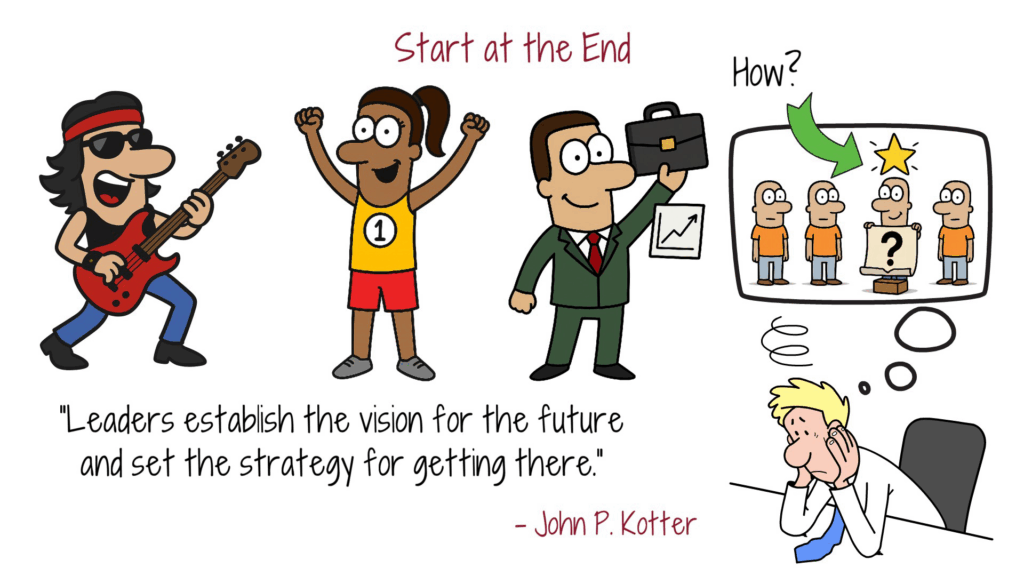
Harvard Professor John P. Kotter said,
“Leaders establish the vision for the future and set the strategy for getting there.”
Reverse engineering is one way to begin breaking down the steps that could lead to exceptional achievements over time. Look at the end result, and ask yourself, what were the components that made this a success? Things like education, practice, mentors, and networking could be a few of the contributing factors on the path to success.
Once you’ve identified certain steps and abilities needed to reach the goal, then you might ask yourself how they achieved those steps? Many business owners started out by working for someone else where they can learn as much as possible about the industry they’re interested in. Getting knowledge and experience could be their first step. Then they might find a mentor that takes them to the next level.
Successful people know that getting ahead involves having a solid plan. And observing others who have reached similar goals can be helpful. Once you’ve determined the path that others have taken, how can you use similar steps to create your own strategy?
Deliberate Practice
We’ve all heard the phrase, “practice makes perfect.” Although practice is important, perfection is not the goal. The idea is to practice with continual improvement. Then combine that with the objective of a long term goal, as opposed to immediate rewards.
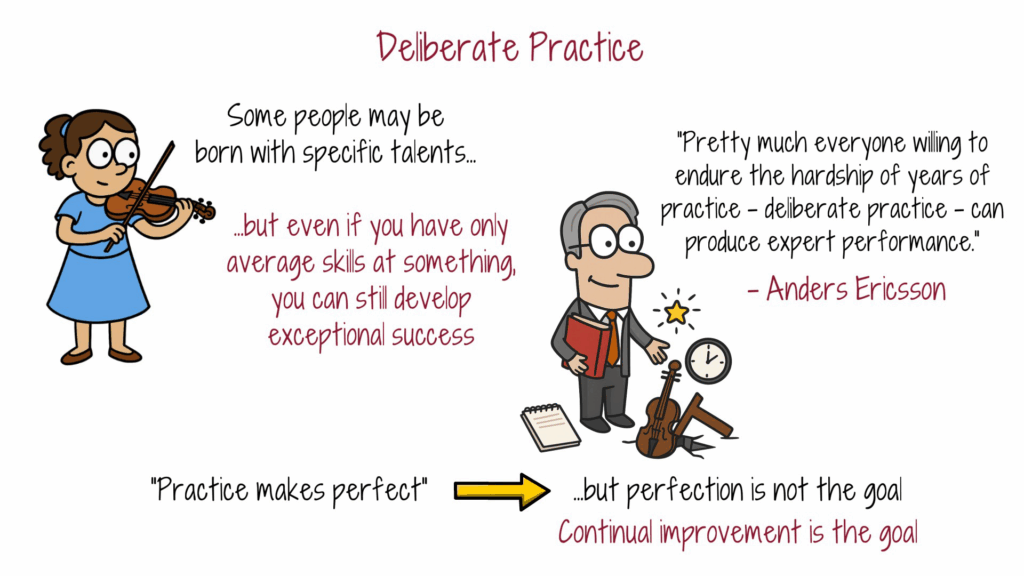
Some people may be born with specific talents, such as Hilary Hahn who was a child prodigy on violin, beginning at age 3. But even if you have only average skills at something, you can still develop exceptional success.
Author Anders Ericsson wrote,
“Pretty much everyone willing to endure the hardship of years of practice -deliberate practice- can produce expert performance.”
Deliberate practice is what makes the difference. It’s making a detailed plan focused on gradual improvements. It’s more focused than just doing repetitions.
The 5 Principles of Deliberate Practice are:
- Observe: What are the best of the best doing that makes them the best?
- Develop a detailed plan. Break down each component like a recipe.
- Have the right mental representation. Know what quality looks like, sounds like, and feels like. How do the best performers think?
- Be fully engaged in regular deliberate practice while doing it.
- Feedback. Have a coach or trainer that can correct you “in the moment” or encourage what you’re doing right.
Regular practice is when you’re doing something, working hard at it, and hoping for the best. While deliberate practice also involves dedication to practice, it goes a little further by including a detailed plan focused on gradual improvement. It’s about breaking down steps into specific tasks and mastering each one. It targets specific areas and develops specific results.
With regular repetitive practice, you might get bored or discouraged. But when utilizing deliberate practice, part of the plan is to be mindful about staying motivated. It’s important to check your self doubt, and not get discouraged by criticism or setbacks.
Focus on the Details
When developing your step by step plan, it’s important to be specific and pay attention to details. Part of your deliberate practice involves identifying specific parts and continually working on them.
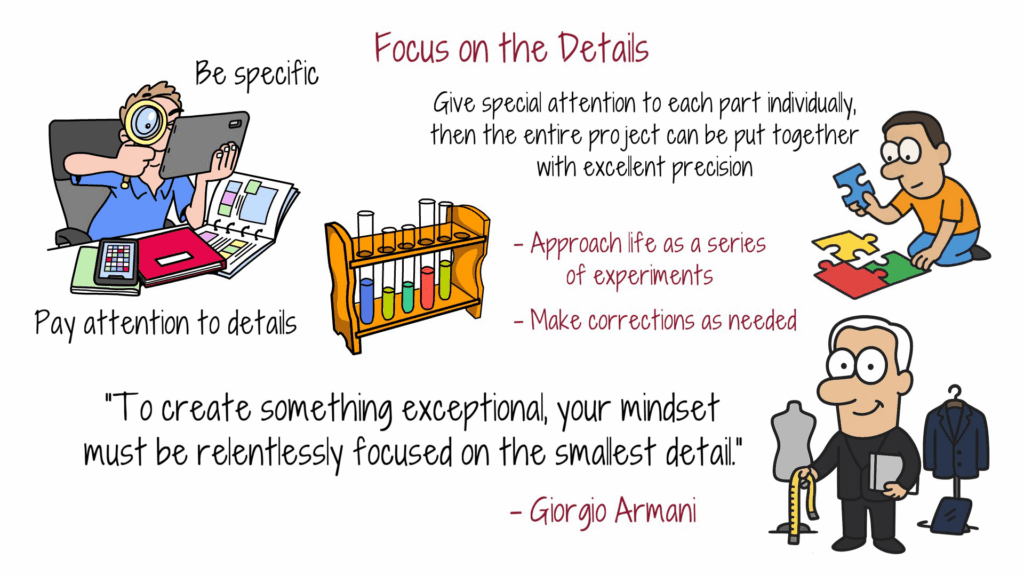
“To create something exceptional, your mindset must be relentlessly focused on the smallest detail.”
This was said by Italian Fashion Designer, Giorgio Armani.
When you think of details, you might envision them as parts of a whole. When you give special attention to each one individually, the entire project can be put together with excellent precision.
Continue to shape each step as you go, making corrections as needed. If something isn’t working, you can always try something else.
When you approach life as a series of experiments, you can deal with trial and error as it occurs. Not everything will be a success the first time around, so treat failure as part of the learning process, and keep going.
Control Friction to Shape Habits
Adjust your environment to make good habits easier and bad habits harder through strategies that create or reduce friction.
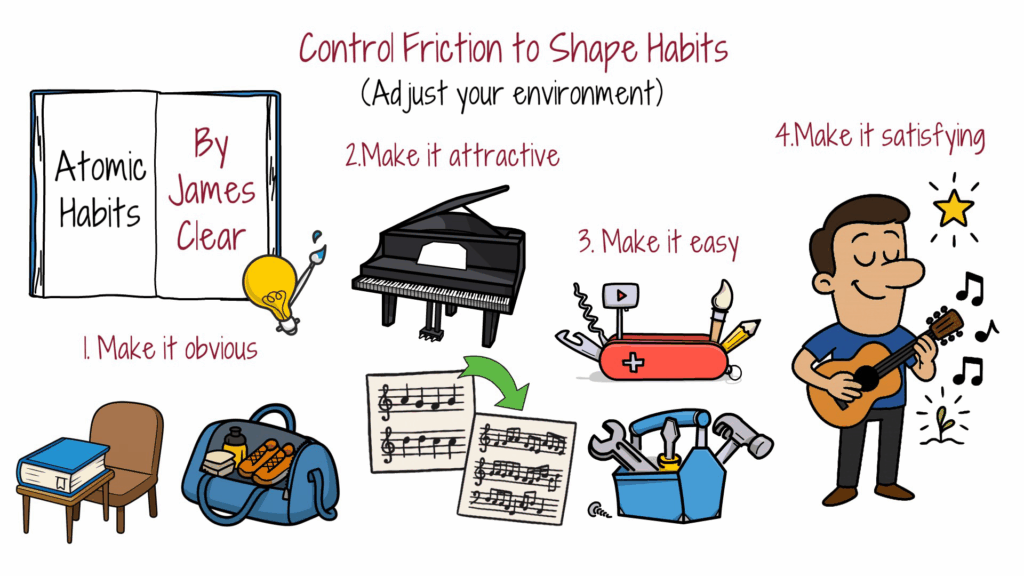
In his book, Atomic Habits, James Clear defines the four laws of habit. When you are wanting to reinforce a good habit, these laws can help reduce the friction and allow your best chance at success.
- Make it obvious. When you make a habit easily accessible, you are more likely to do it. If it’s reading a book, leave it plain sight next to your favorite chair. If it’s a daily workout at the gym, have your gym bag packed and ready to go.
- Make it attractive. Start with what you like most and once your momentum is established, follow up with your less desired tasks. For example, if you’re practicing piano skills, play your favorite song first. Then work on the more difficult pieces once you’ve warmed up.
- Make it easy. Don’t create needless friction by making it a chore. If all the materials or tools you need to do something are ready for use, the task itself can be performed more easily. Staying organized can reduce friction by knowing where things are.
- Make it satisfying. Be sure that the habit you are developing is something you really want to do. If you like what you’re doing, and can see the positive results, you’ll want to do it more often.
On the other hand, when you want to do less of something, increasing friction is one way to go. Make the habit more difficult to accomplish. Make it so hard to even begin that you don’t even want to think about it. For example, if you’re trying to stop eating sweets, put them in a sealed container in the back of the cupboard, so you have to take everything else out to get to them.
If you’re trying to do less impulse buying at the store, leave your credit cards at home and just carry cash, making larger purchases more difficult. If you’re trying to be less distracted during work times, you could try adding friction to the use of electronic devices, by putting them in another room.
The main thing is if you’re wanting to cultivate a positive action, make it easy. And if you’re trying to avoid something that is not working for you, make it difficult.
Choose Your Social Environment
Most people have heard the phrase “birds of a feather flock together.” It’s true that the environment and people you spend time with will inevitably influence your actions and success.

Surround yourself with peers and mentors who contribute to your growth, avoiding toxic or complacent relationships. If you are constantly having to run interference from negative situations and discouragement from people that do not share or understand your vision, you’re wasting precious time and energy.
Author Jim Rohn suggests,
“You are the average of the five people you spend the most time with.”
Look around at your closest relationships and ask yourself how they influence your thoughts and actions.
Final Thoughts
Putting in the hours is important but it’s not the most important. Continual improvement, even if you think you’ve mastered something, is what really leads to exceptional achievements. Once you reach mastery level, then increase the difficulty so you’re always improving, always getting better.
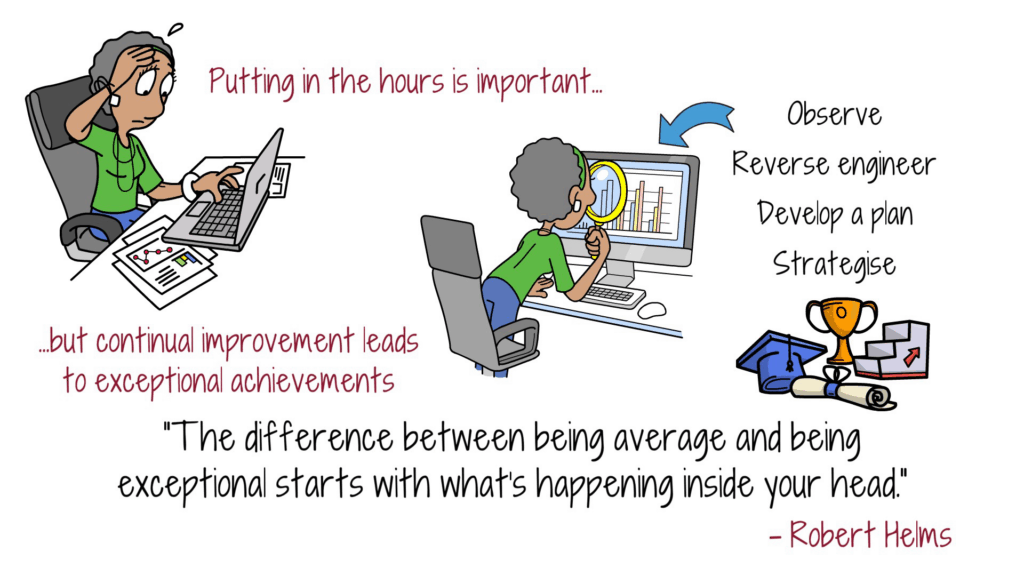
Author and Real Estate Advisor Robert Helms stated,
“The difference between being average and being exceptional starts with what’s happening inside your head.”
By observing what you want, using reverse engineering to develop a step by step plan, and strategize the best habits and environment to get there, your goals of getting ahead and being exceptional are within your grasp.
